Anxiang Zeng
Embed Progressive Implicit Preference in Unified Space for Deep Collaborative Filtering
May 28, 2025Abstract:Embedding-based collaborative filtering, often coupled with nearest neighbor search, is widely deployed in large-scale recommender systems for personalized content selection. Modern systems leverage multiple implicit feedback signals (e.g., clicks, add to cart, purchases) to model user preferences comprehensively. However, prevailing approaches adopt a feedback-wise modeling paradigm, which (1) fails to capture the structured progression of user engagement entailed among different feedback and (2) embeds feedback-specific information into disjoint spaces, making representations incommensurable, increasing system complexity, and leading to suboptimal retrieval performance. A promising alternative is Ordinal Logistic Regression (OLR), which explicitly models discrete ordered relations. However, existing OLR-based recommendation models mainly focus on explicit feedback (e.g., movie ratings) and struggle with implicit, correlated feedback, where ordering is vague and non-linear. Moreover, standard OLR lacks flexibility in handling feedback-dependent covariates, resulting in suboptimal performance in real-world systems. To address these limitations, we propose Generalized Neural Ordinal Logistic Regression (GNOLR), which encodes multiple feature-feedback dependencies into a unified, structured embedding space and enforces feedback-specific dependency learning through a nested optimization framework. Thus, GNOLR enhances predictive accuracy, captures the progression of user engagement, and simplifies the retrieval process. We establish a theoretical comparison with existing paradigms, demonstrating how GNOLR avoids disjoint spaces while maintaining effectiveness. Extensive experiments on ten real-world datasets show that GNOLR significantly outperforms state-of-the-art methods in efficiency and adaptability.
Optimal Transport-Based Token Weighting scheme for Enhanced Preference Optimization
May 24, 2025Abstract:Direct Preference Optimization (DPO) has emerged as a promising framework for aligning Large Language Models (LLMs) with human preferences by directly optimizing the log-likelihood difference between chosen and rejected responses. However, existing methods assign equal importance to all tokens in the response, while humans focus on more meaningful parts. This leads to suboptimal preference optimization, as irrelevant or noisy tokens disproportionately influence DPO loss. To address this limitation, we propose \textbf{O}ptimal \textbf{T}ransport-based token weighting scheme for enhancing direct \textbf{P}reference \textbf{O}ptimization (OTPO). By emphasizing semantically meaningful token pairs and de-emphasizing less relevant ones, our method introduces a context-aware token weighting scheme that yields a more contrastive reward difference estimate. This adaptive weighting enhances reward stability, improves interpretability, and ensures that preference optimization focuses on meaningful differences between responses. Extensive experiments have validated OTPO's effectiveness in improving instruction-following ability across various settings\footnote{Code is available at https://github.com/Mimasss2/OTPO.}.
Establishing Reliability Metrics for Reward Models in Large Language Models
Apr 21, 2025Abstract:The reward model (RM) that represents human preferences plays a crucial role in optimizing the outputs of large language models (LLMs), e.g., through reinforcement learning from human feedback (RLHF) or rejection sampling. However, a long challenge for RM is its uncertain reliability, i.e., LLM outputs with higher rewards may not align with actual human preferences. Currently, there is a lack of a convincing metric to quantify the reliability of RMs. To bridge this gap, we propose the \textit{\underline{R}eliable at \underline{$\eta$}} (RETA) metric, which directly measures the reliability of an RM by evaluating the average quality (scored by an oracle) of the top $\eta$ quantile responses assessed by an RM. On top of RETA, we present an integrated benchmarking pipeline that allows anyone to evaluate their own RM without incurring additional Oracle labeling costs. Extensive experimental studies demonstrate the superior stability of RETA metric, providing solid evaluations of the reliability of various publicly available and proprietary RMs. When dealing with an unreliable RM, we can use the RETA metric to identify the optimal quantile from which to select the responses.
Stitching Inner Product and Euclidean Metrics for Topology-aware Maximum Inner Product Search
Apr 21, 2025Abstract:Maximum Inner Product Search (MIPS) is a fundamental challenge in machine learning and information retrieval, particularly in high-dimensional data applications. Existing approaches to MIPS either rely solely on Inner Product (IP) similarity, which faces issues with local optima and redundant computations, or reduce the MIPS problem to the Nearest Neighbor Search under the Euclidean metric via space projection, leading to topology destruction and information loss. Despite the divergence of the two paradigms, we argue that there is no inherent binary opposition between IP and Euclidean metrics. By stitching IP and Euclidean in the design of indexing and search algorithms, we can significantly enhance MIPS performance. Specifically, this paper explores the theoretical and empirical connections between these two metrics from the MIPS perspective. Our investigation, grounded in graph-based search, reveals that different indexing and search strategies offer distinct advantages for MIPS, depending on the underlying data topology. Building on these insights, we introduce a novel graph-based index called Metric-Amphibious Graph (MAG) and a corresponding search algorithm, Adaptive Navigation with Metric Switch (ANMS). To facilitate parameter tuning for optimal performance, we identify three statistical indicators that capture essential data topology properties and correlate strongly with parameter tuning. Extensive experiments on 12 real-world datasets demonstrate that MAG outperforms existing state-of-the-art methods, achieving up to 4x search speedup while maintaining adaptability and scalability.
Transformer-empowered Multi-modal Item Embedding for Enhanced Image Search in E-Commerce
Nov 29, 2023Abstract:Over the past decade, significant advances have been made in the field of image search for e-commerce applications. Traditional image-to-image retrieval models, which focus solely on image details such as texture, tend to overlook useful semantic information contained within the images. As a result, the retrieved products might possess similar image details, but fail to fulfil the user's search goals. Moreover, the use of image-to-image retrieval models for products containing multiple images results in significant online product feature storage overhead and complex mapping implementations. In this paper, we report the design and deployment of the proposed Multi-modal Item Embedding Model (MIEM) to address these limitations. It is capable of utilizing both textual information and multiple images about a product to construct meaningful product features. By leveraging semantic information from images, MIEM effectively supplements the image search process, improving the overall accuracy of retrieval results. MIEM has become an integral part of the Shopee image search platform. Since its deployment in March 2023, it has achieved a remarkable 9.90% increase in terms of clicks per user and a 4.23% boost in terms of orders per user for the image search feature on the Shopee e-commerce platform.
Recurrent Temporal Revision Graph Networks
Sep 26, 2023Abstract:Temporal graphs offer more accurate modeling of many real-world scenarios than static graphs. However, neighbor aggregation, a critical building block of graph networks, for temporal graphs, is currently straightforwardly extended from that of static graphs. It can be computationally expensive when involving all historical neighbors during such aggregation. In practice, typically only a subset of the most recent neighbors are involved. However, such subsampling leads to incomplete and biased neighbor information. To address this limitation, we propose a novel framework for temporal neighbor aggregation that uses the recurrent neural network with node-wise hidden states to integrate information from all historical neighbors for each node to acquire the complete neighbor information. We demonstrate the superior theoretical expressiveness of the proposed framework as well as its state-of-the-art performance in real-world applications. Notably, it achieves a significant +9.6% improvement on averaged precision in a real-world Ecommerce dataset over existing methods on 2-layer models.
Clustered Embedding Learning for Recommender Systems
Feb 10, 2023Abstract:In recent years, recommender systems have advanced rapidly, where embedding learning for users and items plays a critical role. A standard method learns a unique embedding vector for each user and item. However, such a method has two important limitations in real-world applications: 1) it is hard to learn embeddings that generalize well for users and items with rare interactions on their own; and 2) it may incur unbearably high memory costs when the number of users and items scales up. Existing approaches either can only address one of the limitations or have flawed overall performances. In this paper, we propose Clustered Embedding Learning (CEL) as an integrated solution to these two problems. CEL is a plug-and-play embedding learning framework that can be combined with any differentiable feature interaction model. It is capable of achieving improved performance, especially for cold users and items, with reduced memory cost. CEL enables automatic and dynamic clustering of users and items in a top-down fashion, where clustered entities jointly learn a shared embedding. The accelerated version of CEL has an optimal time complexity, which supports efficient online updates. Theoretically, we prove the identifiability and the existence of a unique optimal number of clusters for CEL in the context of nonnegative matrix factorization. Empirically, we validate the effectiveness of CEL on three public datasets and one business dataset, showing its consistently superior performance against current state-of-the-art methods. In particular, when incorporating CEL into the business model, it brings an improvement of $+0.6\%$ in AUC, which translates into a significant revenue gain; meanwhile, the size of the embedding table gets $2650$ times smaller.
Learning an Adaptive Meta Model-Generator for Incrementally Updating Recommender Systems
Nov 08, 2021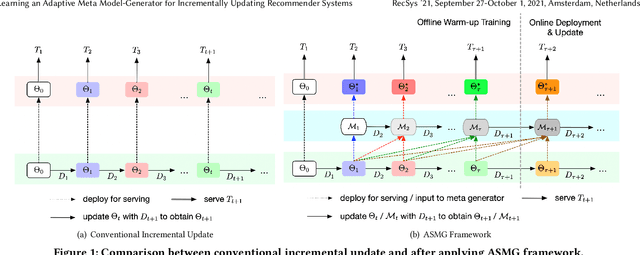
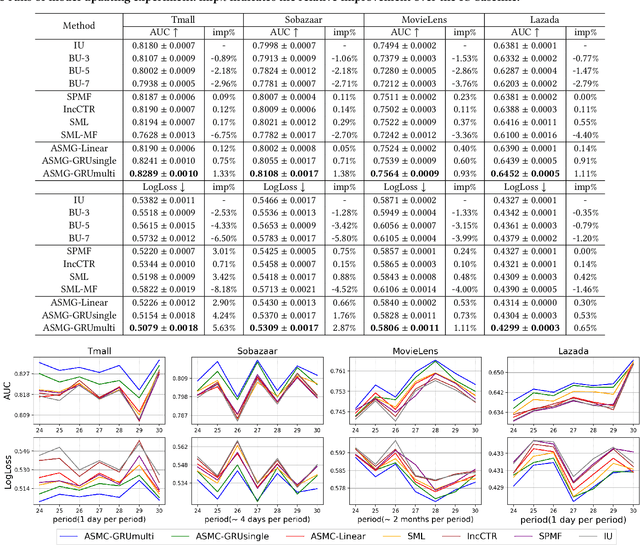
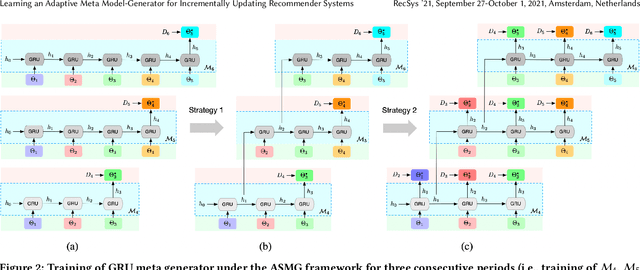

Abstract:Recommender Systems (RSs) in real-world applications often deal with billions of user interactions daily. To capture the most recent trends effectively, it is common to update the model incrementally using only the newly arrived data. However, this may impede the model's ability to retain long-term information due to the potential overfitting and forgetting issues. To address this problem, we propose a novel Adaptive Sequential Model Generation (ASMG) framework, which generates a better serving model from a sequence of historical models via a meta generator. For the design of the meta generator, we propose to employ Gated Recurrent Units (GRUs) to leverage its ability to capture the long-term dependencies. We further introduce some novel strategies to apply together with the GRU meta generator, which not only improve its computational efficiency but also enable more accurate sequential modeling. By instantiating the model-agnostic framework on a general deep learning-based RS model, we demonstrate that our method achieves state-of-the-art performance on three public datasets and one industrial dataset.
Diversity Regularized Interests Modeling for Recommender Systems
Mar 23, 2021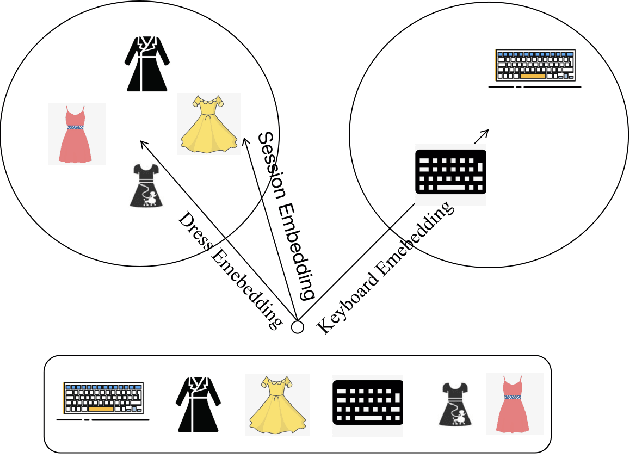
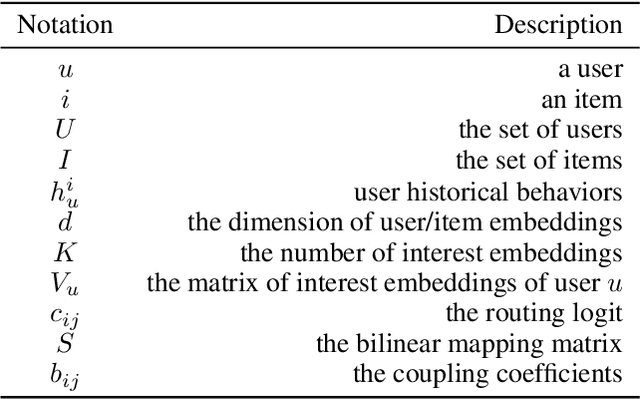
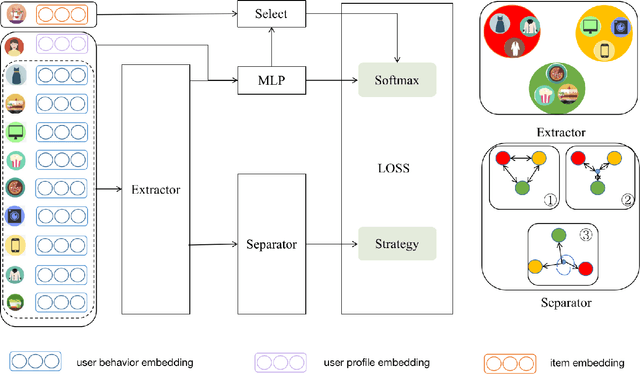

Abstract:With the rapid development of E-commerce and the increase in the quantity of items, users are presented with more items hence their interests broaden. It is increasingly difficult to model user intentions with traditional methods, which model the user's preference for an item by combining a single user vector and an item vector. Recently, some methods are proposed to generate multiple user interest vectors and achieve better performance compared to traditional methods. However, empirical studies demonstrate that vectors generated from these multi-interests methods are sometimes homogeneous, which may lead to sub-optimal performance. In this paper, we propose a novel method of Diversity Regularized Interests Modeling (DRIM) for Recommender Systems. We apply a capsule network in a multi-interest extractor to generate multiple user interest vectors. Each interest of the user should have a certain degree of distinction, thus we introduce three strategies as the diversity regularized separator to separate multiple user interest vectors. Experimental results on public and industrial data sets demonstrate the ability of the model to capture different interests of a user and the superior performance of the proposed approach.
Hybrid Interest Modeling for Long-tailed Users
Dec 29, 2020

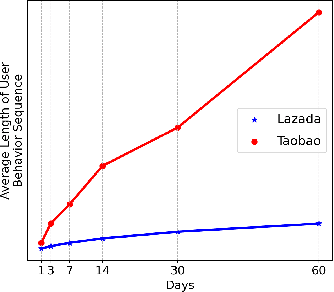
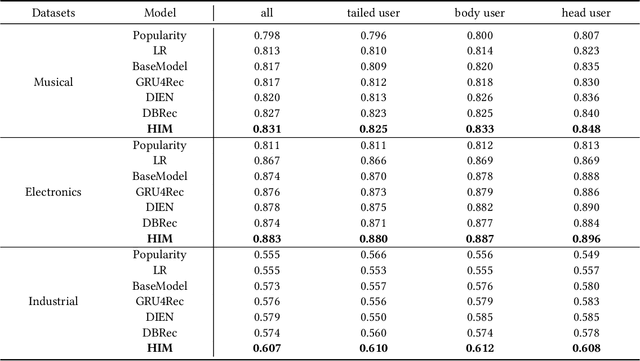
Abstract:User behavior modeling is a key technique for recommender systems. However, most methods focus on head users with large-scale interactions and hence suffer from data sparsity issues. Several solutions integrate side information such as demographic features and product reviews, another is to transfer knowledge from other rich data sources. We argue that current methods are limited by the strict privacy policy and have low scalability in real-world applications and few works consider the behavioral characteristics behind long-tailed users. In this work, we propose the Hybrid Interest Modeling (HIM) network to hybrid both personalized interest and semi-personalized interest in learning long-tailed users' preferences in the recommendation. To achieve this, we first design the User Behavior Pyramid (UBP) module to capture the fine-grained personalized interest of high confidence from sparse even noisy positive feedbacks. Moreover, the individual interaction is too sparse and not enough for modeling user interest adequately, we design the User Behavior Clustering (UBC) module to learn latent user interest groups with self-supervised learning mechanism novelly, which capture coarse-grained semi-personalized interest from group-item interaction data. Extensive experiments on both public and industrial datasets verify the superiority of HIM compared with the state-of-the-art baselines.
 Add to Chrome
Add to Chrome Add to Firefox
Add to Firefox Add to Edge
Add to Edge